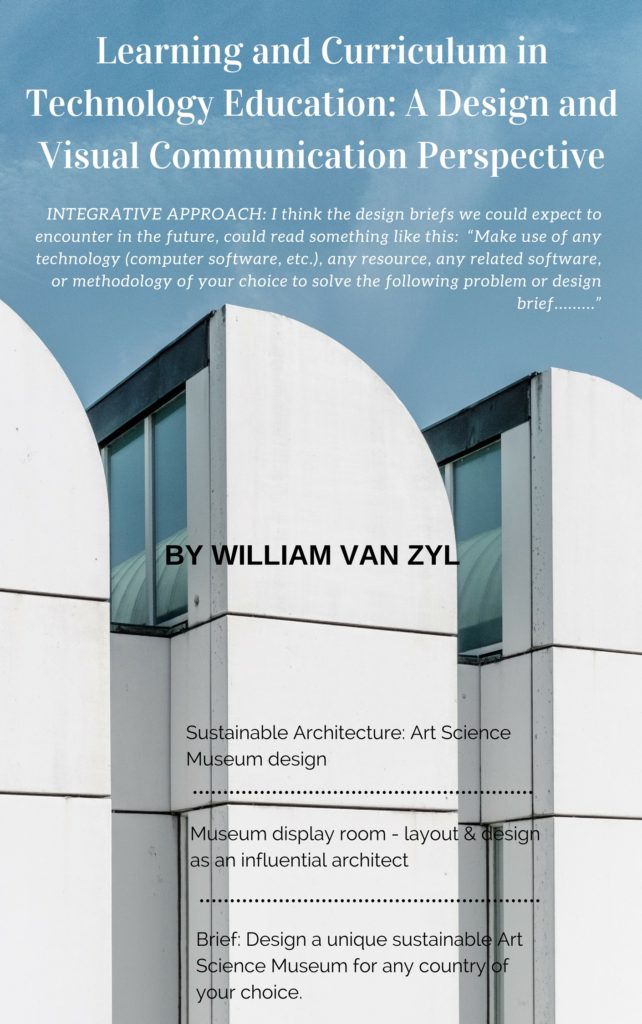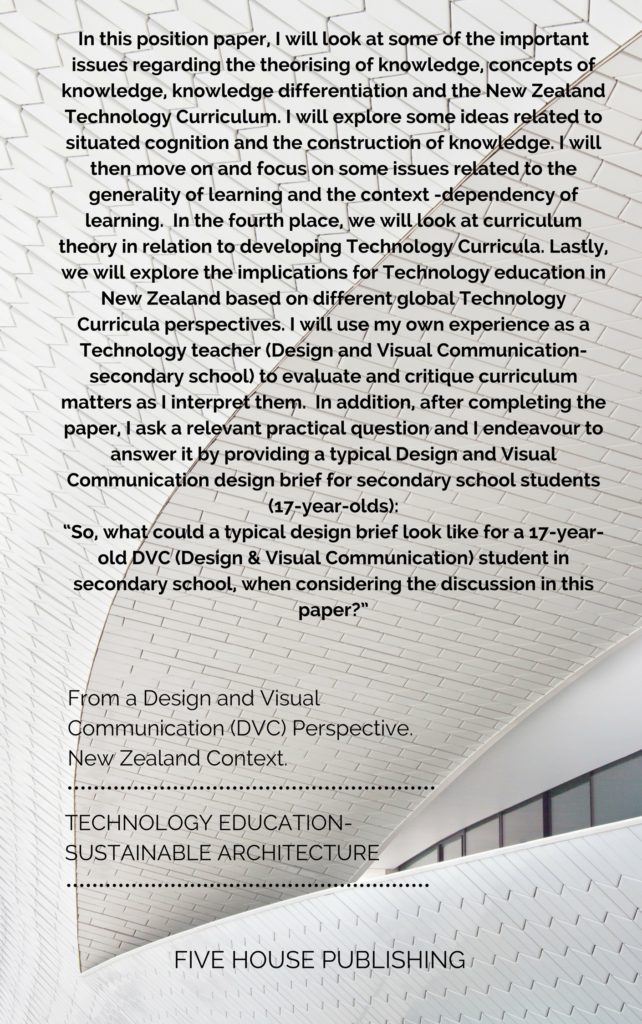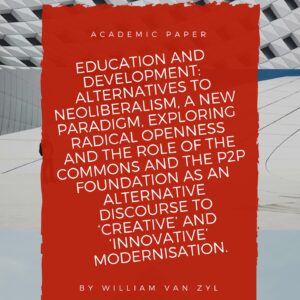Original price was: $2.99.$0.99Current price is: $0.99.
Book details:
9500 words with images, links, and video links
60 pages (size A4)
APA Referencing
INTRODUCTION:
In this position paper, I will look at some of the important issues regarding the theorising of knowledge, concepts of knowledge, knowledge differentiation and the New Zealand Technology Curriculum. I will explore some ideas related to situated cognition and the construction of knowledge. I will then move on and focus on some issues related to the generality of learning and the context -dependency of learning. In the fourth place, we will look at curriculum theory in relation to developing Technology Curricula. Lastly, we will explore the implications for Technology education in New Zealand based on different global Technology Curricula perspectives. I will use my own experience as a Technology teacher (Design and Visual Communication-secondary school) to evaluate and critique curriculum matters as I interpret them. In addition, after completing the paper, I ask a relevant practical question and I endeavour to answer it by providing a typical Design and Visual Communication design brief for secondary school students (17-year-olds):
“So, what could a typical design brief look like for a 17-year-old DVC (Design & Visual Communication) student in secondary school, when considering the discussion in this paper?”
DESIGN BRIEFS:
Situation 1: You are a famous architect and you are contracted by a specific country to design a unique sustainable Art Science Museum. The brief includes the incorporation of the country’s culture, the symbolism, the technology, the art, the science, the engineering, the values and history of that particular country.
Brief 1: Design a unique sustainable Art Science Museum for any country of your choice.
Situation 2: You have completed your design and presentations (portfolio) of the solution of your sustainable Art Science Museum design and you are offered the opportunity to showcase your design work in one of the local museums. A room is given to you with the freedom to display you work as you wish (no limitations). The size of the room is 10 mx 10 m =100 square metre. With an entrance and exit -2 x arch openings. You have all the museum facilities and equipment at your disposal. For example, data projector, and state of the art computer with all the apps/software you want. Display frames/shelves/tables/pedestals/cabinets, etc. You also have the freedom to have your work printed, enlarged, and mounted at a local print/copy shop. It also includes the opportunity to create your own website. Search the internet for more ideas before you endeavour your planning/ design/layout of the exhibition/display. Obviously, you will start with research and then move on to freehand sketching (generate ideas, ideation, and concepts for the display). Use this opportunity to creatively link your display to the website, to showcase and market your design ideas.
Brief 2: Plan and design a display of your completed design work (Art Science Museum) at a local museum. Create a simple website with menus that includes all the basic information and links to your design work. For example, your exhibition/display locally at the Waikato Museum—New Zealand. In other words, it is the overall plan which includes: Room layout, the position of detailed displays, media used, annotated freehand sketches, work drawings, 3-d model display, on-screen presentation (data projector), pamphlets, website details, and so on. See the Waikato Museum in New Zealand, for a specific local museum, if you choose the Waikato region. Museum: http://waikatomuseum.co.nz/
Description
Contents
From a Design and Visual Communication (DVC – New Zealand Context). 8
Background to the academic paper: 8
Here follows a typical design brief for 17-year old students. 8
Introduction. 11
Referent-centred, and problem-centred knowledge in Technology Education. 12
Education and thinking: a brief overview. 13
Discussions: The use of extended problems. 14
Conceptual knowledge: Constructivism and Schemata. 14
Situated Cognition—learning and enculturation. 15
Cognitive apprenticeships—collaborative learning. 18
Situated Cognition: apprenticeship. 20
List of components of the ‘u-booten’: 22
Dispositional theory of thinking (generality vs. context bound). 27
Technology Curricula: the past and its influence in the future. 28
Technology Education Curriculum: intellectual processes. 29
Five broad, general principles from Cognitive Research. 32
Theoretical Rationale: personal relevance. 34
Theoretical Rationale: social reconstruction. 35
Technology in the New Zealand school curriculum: a comparative approach. 36
Technology Business Studies—an addition to the Technology curriculum.. 42
Conclusion. 43
So—from a practical point of view—what could a typical design brief look like for 17-year-old DVC (Design & Visual C. 43
Quick specifications for the design of your sustainable Art Science Museum: 47
Illustrating and presenting your work: 48
Financial and economic study of your Art Science Museum: 50
Consider (estimate) the amount of rainwater harvested per year (to water gardens) 50
PHOTOVOLTAIC PANELS. 52
WIND TURBINES. 52
*For teachers of other subjects—Working together on a design brief, integrating the brief into all subject areas. 53
Website design: 54
Image: Screenshot of an online screen recording option: screencast-o-matic.com.. 54
Culmination of the completed work: 55
Awards could include: 55
APA Referencing & Citation: 57
References: 58
About the Author: 60


EXCERPTS:
Conceptual knowledge: Constructivism and Schemata.
“When concepts are introduced in school, they are not transmitted to students, but students will attempt to fit them into the models or concepts they currently have” (McCormick, 1997, p. 148).
I have experienced that when I give a problem or design brief to secondary school students, they will not start at the beginning of the technological cycle, but everyone would start at a completely different point in the cycle. For example, some students would start with research, some would start with generating ideas, and some would discuss their ideas with a friend, and so on. The most success was obtained by ‘letting go’, allowing students to start where they want to. It means allowing students to do their ‘own thing’. It seems as if students will draw on their past experiences mainly to try and solve the problem or design brief. By leaving the students to do their “own thing”—drawing on their own experience—the assignments are more successful and more enjoyable to them. It allows students to work within their own chosen context and level of experience/knowledge. For example, in designing a sustainable restaurant (Y12 Graphics/DVC), one student started off by designing an Art Nouveau door, and the other started off with the menu for the restaurant. Every single student takes a different course of action and starts at a different place. Students solve problems and build knowledge on their current experience.
Situated Cognition—learning and enculturation.
The collaborative process within a community of practice—for example, a group of Design and Visual Communication students—has huge benefits on the ‘culture’ of the group. Brown, Collins and Duguid (1989) sum it up very succinctly:
“Given the chance to observe and practice in situ the behaviour of members of a culture, people pick up relevant jargon, imitate behaviour, and gradually start to act in accordance with its norms” (Brown, Collins & Duguid, 1989,p. 34).
They (Brown, et al, 1989) continue to explain how the negotiations (collaboration) changes and shapes the culture of the specific group or community of learners. Teachers should consider the possible ‘group culture’ when combining and choosing members of a group to solve design problems. For example, to combine biologists, scientists and mathematicians with artists, historians, linguists, and so on will have a significant effect on the design culture of the group.
“The activities of a domain are framed by its culture. Their meaning and purpose are socially constructed through negotiations among present and past members” (Brown, Collins & Duguid, 1989, p. 34).





